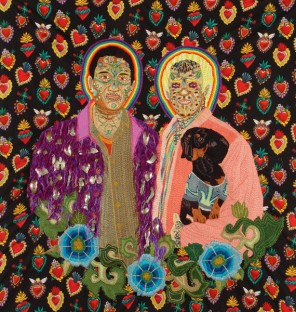Latin American Fibers: Fall 2013 Surface Design Journal
November 2, 2013

A potent trend throughout Latin America is the transformation of traditional textile techniques into contemporary art forms, beautifully illustrated by the stitched detail on our cover. Mexican artist Natividad Amador achieves this stunning surface design with hook- tambour embroidery commonly used to embellish women’s blouses. The finished piece is Amador’s reinterpretation of a painting by her mentor Alejandro Santiago.
I hope you enjoy this initial overview of Latin American textile artists and their stories. We look forward to featuring many more in future issues of the Journal!
Click here to read a sample of this issue at surfacedesign.org/journal. Click here to buy this issue in our new SDA Marketplace! surfacedesign.org/marketplace Find related links to this issue’s profiles and features below. Velocity and Memory: Betsabeé Romero
Velocity and Memory: Betsabeé Romero
By Pamela Scheinman
On a conceptual level, Romero’s decorated cars oppose speed and macho NASCAR culture. They are feminized and given stories, a history. They also are dressed up, like the paper doll clothes she invented in sets as a child. For velocity, she substitutes memory. Memory, like the fabrication of textiles, is a slow accumulative process. Her own process is equally generative.
Betsabeé Romero‘s next solo exhibition will be at Juan Ruiz Gallery in Miami, Florida November 26, 2013–January 31, 2014 during the Miami Art Fairs.
 Dynamic Latin American Duos
Dynamic Latin American Duos
by Vic De La Rosa and Kate Nartker
The rosters of recent international biennials and art fairs worldwide show an increased number of collaborative groups. Has there been a rise in the acceptance and recognition of multiple authors in the art world or has there simply been a rise in the number of Gen Y and Millennial artists for whom working in this egalitarian manner is the norm? In either case, there has been a paradigm shift in how collaborative versus solitary art making is viewed today.
 Transforming Textile Traditions in Peru
Transforming Textile Traditions in Peru
By Marilyn Murphy
“I have learned that each and every piece of cloth embodies the spirit, skill, and personal history of an individual weaver. Weaving is a living art, an expression of culture, geography, and history. It ties together with an endless thread of emotional life of my people.”—Nilda Callañaupa Alvarez, Founder and Director of The Center for Traditional Textiles of CuscoThe Center for Traditional Textiles of Cusco (CTTC)
To purchase CTTC products, visit www.clothroads.com.
To attend the Tinkuy de Tejedores conference November 12-15, 2013 in Cusco, Peru, and become involved with CTTC, visit www.andeantextilearts.org.
 Gego: A Textile in Three Dimensions
Gego: A Textile in Three Dimensions
By Warren Seelig
Nearly 20 years after her death, an artist named Gego has emerged as possibly the most important modern artist whose innovation was given little recognition while she was alive. The European émigré to Latin America was an anomaly in her time, and even today there is no clear definition of what to call her work. Is it sculpture? Is it drawing? Some have referred to it as kinetic art and others as optical. Or could it be understood as an open weave textile in three dimensions?
Gego: Line as Object will be on display at Hamburger Kunsthalle Museum in Hamburg, Germany (November 29, 2013–March 2, 2014).
Fundacion Gego (Gego Foundation), Caracas, Venezuela
 Art and Opportunity in Guatemala
Art and Opportunity in Guatemala
By Deborah Chandler
Since 1989, Mayan Hands [fair trade organization] has helped hundreds of women working in cooperative groups with “a hand up instead of a handout” by providing work, and therefore income, on a steady and fair trade basis.
 Interview:
Interview:
Héctor Meneses Lozano
Director, Museo Textil de Oaxaca, Mexico
with Journal Editor Marci Rae McDade
The textile traditions of Oaxaca, Mexico, have been admired for centuries. The Museo Textil de Oaxaca (MTO) opened its doors five years ago to add cultural context and connectivity to these treasures. Alongside pieces from a grow- ing collection of nearly 6,000 objects, the Museum presents enriching educational programs, artisan markets, and thought- provoking contemporary exhibitions by both regional and international artists. MTO Director Héctor Manuel Meneses Lozano gives us the grand tour in a recent e-interview.
Museo Textil de Oaxaca (MTO) Oaxaca, Mexico
 Latin American Textile Art . . . in process
Latin American Textile Art . . . in process
By Paulina Ortiz
How can Latin America contribute textile creativity and communicate the potential for furthering its interconnectivity, development and visibility on the global artistic scene?
There is no easy answer to this question if we take Latin America as a whole, with all the different ethnic groups, nationalities, and preferences coexisting among our nations.
Argentine Center for Textile Art (CAAT)
European Textile Network (ETN)
Ibero-American Textile Network (Redtextilia)
World Textile Art Organization (WTA)
 The Miami Art Fairs: Fiber, Fiber Everywhere
The Miami Art Fairs: Fiber, Fiber Everywhere
By Joanne Mattera
Each year, as the number of international exhibition venues in Miami, Florida, has increased (in 2012, there were some 20 fairs), the amount of fiber on exhibition has increased as well. The 2013 Miami art fairs will take place December 3–8, 2013 with most openings on Wednesday or Thursday nights. Art Basel Miami Beach, Aqua Art , Art Miami, NADA, Design Miami, Untitled, Context, Miami Project, and Pulse are just a few worth Googling!
Joanne Mattera artist, Eighth International Encaustic Conference 2014
Click here to buy this issue in our new SDA Marketplace! surfacedesign.org/marketplace Click here to read a sample of this issue at surfacedesign.org/journal.

